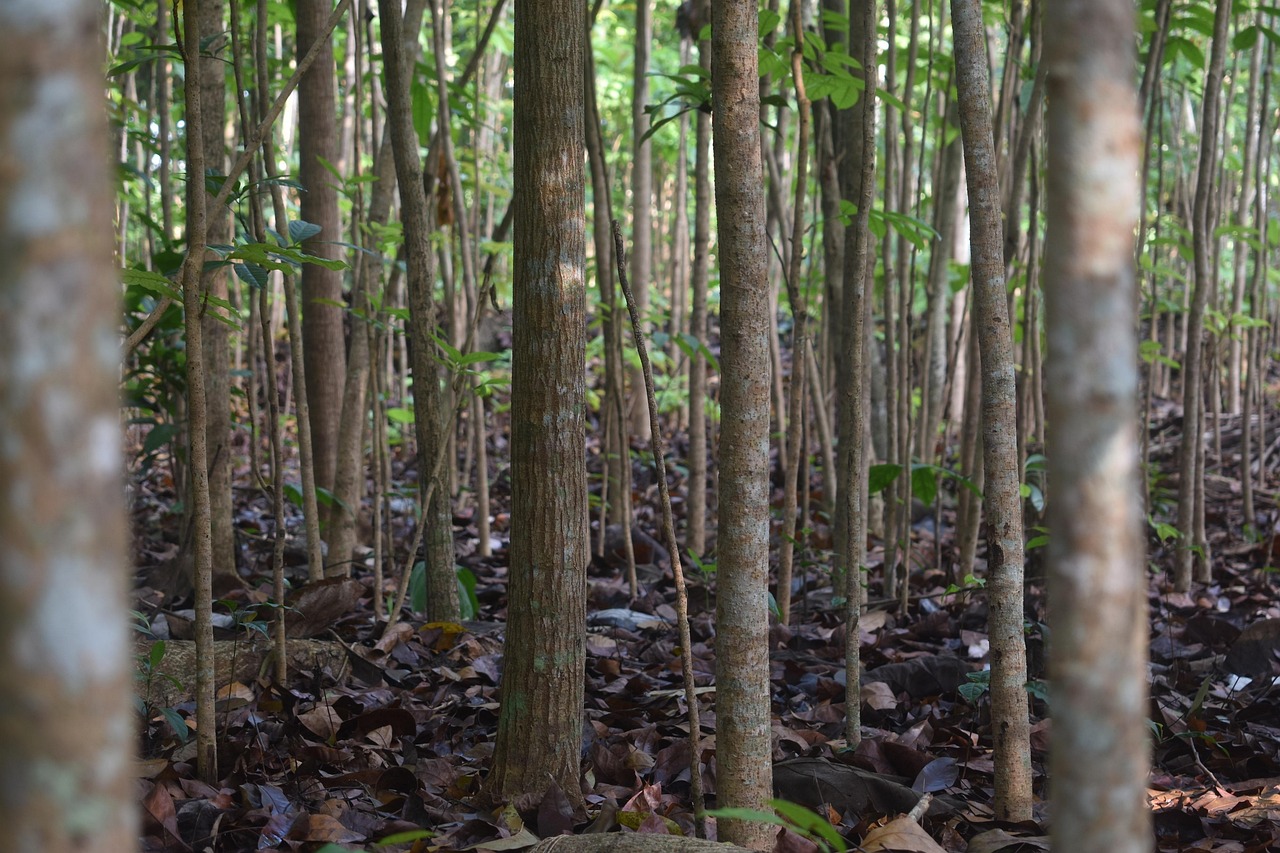Mahogany trees exhibit a moderate growth rate in sustainable forests, typically reaching heights of 60 to 80 feet and diameters of 24 to 36 inches within 30 to 50 years. Their growth can be influenced by factors such as soil quality, climate, and forest management practices.
Understanding Mahogany Trees
Mahogany trees, scientifically known as Swietenia macrophylla, are renowned for their beautiful wood and ecological importance. Native to the tropical regions of the Americas, these trees have become a symbol of sustainable forestry practices. Their wood is highly sought after for furniture and cabinetry, leading to various conservation efforts aimed at preserving their habitats.

The growth rate of mahogany trees can vary significantly based on several environmental factors. These include soil type, moisture levels, sunlight availability, and overall forest management. In sustainable forests, where practices are implemented to maintain ecological balance, mahogany trees tend to thrive better compared to those in unmanaged or over-harvested areas.
Factors Affecting Growth Rate
Several key factors influence the growth rate of mahogany trees in sustainable forests:
- Soil Quality: Well-drained, fertile soils enhance growth rates. Nutrient-rich soils provide essential minerals required for healthy tree development.
- Climate: Mahogany trees flourish in warm, humid climates. Adequate rainfall and temperature regulation are crucial for optimal growth.
- Light Exposure: These trees require full sunlight for at least part of the day. Competitively shaded areas may hinder their growth.
- Forest Management: Sustainable practices such as selective logging and reforestation help maintain a healthy ecosystem that supports growth.
Growth Rate Overview
The growth rate of mahogany trees can be categorized based on their age and environmental conditions. A summary of their growth stages is presented in the following table:

| Age (Years) | Height (Feet) | Diameter (Inches) |
|---|---|---|
| 5 | 10 – 15 | 2 – 4 |
| 10 | 20 – 30 | 6 – 8 |
| 20 | 40 – 50 | 12 – 16 |
| 30 | 60 – 80 | 24 – 36 |
This table illustrates the expected growth progression of mahogany trees under optimal conditions. It is essential to note that these figures can vary based on specific local conditions and management practices.
The Importance of Sustainable Forestry
Sustainable forestry plays a vital role in enhancing the growth rates of mahogany trees. By implementing methods that protect the environment, promote biodiversity, and ensure the longevity of timber resources, forests can remain productive and resilient. Sustainable practices also help combat deforestation and climate change, preserving habitats for numerous species.
In addition to conservation efforts, sustainable forestry provides economic benefits to local communities. Sustainable harvesting methods can generate income while ensuring that forest resources remain available for future generations. This dual focus on ecological and economic sustainability is critical for the continued success of mahogany tree cultivation.

The Role of Mahogany in Ecosystems
Mahogany trees serve multiple functions within their ecosystems. They provide habitat for a variety of wildlife, contribute to soil health through leaf litter, and help stabilize local climates by acting as carbon sinks. Their majestic stature and dense canopy also create microhabitats that support diverse flora and fauna.
The positive impact of mahogany trees extends beyond their immediate surroundings. By promoting biodiversity and enhancing forest structure, these trees contribute to the overall health of global ecosystems. As such, understanding their growth rates and the conditions that favor their development is crucial for both environmental sustainability and economic viability.
Growth Conditions for Mahogany Trees
To promote optimal growth of mahogany trees, specific environmental conditions must be met. Understanding these conditions allows for better forest management and cultivation practices. Mahogany trees thrive in a variety of settings, but certain factors play a pivotal role in their development.
Soil Requirements
The type and quality of soil directly affect the growth of mahogany trees. Here are some key soil characteristics that are beneficial:

- Well-Drained Soil: Mahogany trees require soil that drains well to prevent root rot and other water-related issues.
- Fertility: Nutrient-rich soils, particularly those high in nitrogen, phosphorus, and potassium, support healthy growth.
- pH Levels: An ideal pH range for mahogany is between 6.0 and 7.5, which promotes nutrient availability.
Climate Preferences
Mahogany trees are native to tropical climates and flourish in warm, humid conditions. The following climate factors are important:
- Temperature: Ideal temperatures range from 77°F to 95°F (25°C to 35°C). Growth is stunted in colder climates.
- Rainfall: Annual rainfall of 40 to 100 inches is optimal. Consistent moisture is crucial during the growing season.
- Humidity: High humidity levels support the tree’s physiological functions and overall health.
Growth Rate Variability
The growth rate of mahogany trees can vary due to several intrinsic and extrinsic factors. Understanding these variables helps in predicting growth outcomes accurately.
Intrinsic Factors
Intrinsic factors refer to the natural characteristics of the mahogany tree itself. Key intrinsic factors include:
- Genetics: Different genetic strains of mahogany may exhibit varied growth rates. Some cultivars are bred specifically for faster growth.
- Aging: Young mahogany trees typically grow faster than older trees. Growth rates can slow significantly after reaching maturity.
Extrinsic Factors
Extrinsic factors encompass environmental conditions and human interventions. These include:
- Pest and Disease Management: Effective management strategies are necessary to prevent infestations that may hinder growth.
- Competition: The presence of other vegetation can impact light availability and nutrient access, affecting growth rates.
- Harvesting Practices: Sustainable harvesting methods can enhance the overall health of a forest, promoting better growth rates for remaining trees.
The Role of Silviculture in Growth Rates
Silviculture refers to the practice of managing the establishment, growth, and regeneration of forests. It plays a crucial role in enhancing the growth rates of mahogany trees. Key silvicultural practices include:
- Selective Logging: This method minimizes damage to the surrounding ecosystem while allowing for the harvesting of mature trees.
- Thinning: Removing some trees can reduce competition for resources, allowing remaining trees to grow more vigorously.
- Reforestation: Planting new mahogany trees helps maintain forest density and supports overall ecosystem health.
Best Practices for Cultivating Mahogany Trees
Implementing best practices in cultivating mahogany trees can significantly improve growth rates. Some recommended practices include:
- Regular Soil Testing: Conduct tests to monitor soil health and make necessary amendments to support tree growth.
- Irrigation Management: Ensure adequate water supply, especially during dry spells, without over-watering.
- Pest Monitoring: Regularly check for signs of pests and diseases to take prompt action when necessary.
The Economic Value of Mahogany Growth Rates
The economic implications of mahogany tree growth rates are significant. Faster growing trees contribute to higher yields and increased profitability for sustainable forestry operations. Some economic aspects to consider include:
- Market Demand: The demand for high-quality mahogany wood remains strong, making efficient growth crucial for meeting market needs.
- Sustainable Practices: Implementing sustainable practices not only enhances growth but also appeals to environmentally conscious consumers.
- Job Creation: Sustainable forestry initiatives create job opportunities in rural areas, contributing to local economies.
The careful management of mahogany tree growth rates leads to both ecological benefits and economic advantages, fostering sustainability in forestry practices.
Challenges in Mahogany Growth and Management
While mahogany trees offer numerous benefits, their growth and management present various challenges. Understanding these challenges is essential for implementing effective strategies that promote healthy growth while ensuring sustainability.
Environmental Threats
Several environmental threats can adversely affect the growth rates of mahogany trees:
- Climate Change: Changing climate conditions can alter rainfall patterns and temperature ranges, impacting the natural growth cycle of mahogany trees.
- Drought: Extended periods of drought can stress trees, leading to reduced growth and increased susceptibility to pests and diseases.
- Invasive Species: Invasive plants and insects can compete with mahogany for resources or introduce diseases that may hinder growth.
Pest and Disease Management
Pests and diseases pose significant threats to the health of mahogany trees. Key pests include bark beetles and leafcutter ants, which can damage leaves and bark, respectively. Effective management practices are necessary to mitigate these risks:
- Integrated Pest Management (IPM): This approach combines biological, cultural, and chemical practices to control pest populations while minimizing environmental impact.
- Regular Monitoring: Consistent observation for signs of infestation or disease allows for timely intervention before significant damage occurs.
- Use of Resistant Varieties: Planting genetically resistant strains of mahogany can reduce vulnerability to certain pests and diseases.
The Role of Technology in Mahogany Cultivation
Advancements in technology are transforming how mahogany trees are cultivated and managed. These innovations enhance growth efficiency and sustainability:
Precision Agriculture
Precision agriculture utilizes technology to monitor and manage agricultural practices more effectively. In the context of mahogany cultivation, this includes:
- Soil Sensors: These devices measure moisture levels and nutrient content, allowing for optimized irrigation and fertilization.
- Drone Technology: Drones can survey large areas of forest, providing data on tree health, growth rates, and overall forest conditions.
Genetic Research
Research into the genetics of mahogany trees is crucial for improving growth rates and resistance to pests. This includes:
- Genetic Mapping: Identifying genes associated with desirable traits can lead to the development of superior cultivars.
- Clonal Propagation: Using clonal propagation techniques, growers can produce genetically identical plants that exhibit enhanced growth characteristics.
Community Involvement in Sustainable Practices
The success of mahogany tree management often hinges on the involvement of local communities. Engaging communities can lead to more sustainable practices and better management outcomes:
Education and Awareness
Educating local populations about the importance of sustainable forestry practices is vital. This can be achieved through:
- Workshops: Hosting workshops on sustainable practices helps community members understand the benefits of responsible forestry.
- Collaboration with NGOs: Partnering with non-governmental organizations can provide resources and expertise to promote sustainable forestry initiatives.
Incentives for Sustainable Practices
Providing incentives for communities to engage in sustainable forestry can lead to positive outcomes. Some potential incentives include:
- Financial Assistance: Offering grants or low-interest loans for sustainable practices encourages investment in proper tree management.
- Market Access: Facilitating access to markets for sustainably harvested wood can enhance economic viability for local producers.
Future Prospects for Mahogany Growth Rates
The future growth rates of mahogany trees are influenced by ongoing research, technological advancements, and sustainable practices. Emerging trends include:
- Sustainable Certification Programs: Certifications such as Forest Stewardship Council (FSC) promote responsible forest management and can enhance marketability.
- Climate-Resilient Practices: Developing methods to adapt to changing climate conditions will be essential for sustaining growth rates in the long term.
By addressing challenges and leveraging technology while involving communities, the future of mahogany tree growth in sustainable forests appears promising. The continued commitment to sustainability will ensure that these valuable trees thrive for generations to come.
Enhancing Sustainable Mahogany Cultivation
As the demand for mahogany wood continues to rise, enhancing sustainable cultivation practices is critical. There are several strategies that can be employed to ensure that mahogany tree growth rates remain robust while protecting the environment.
Agroforestry Integration
Integrating mahogany cultivation within agroforestry systems can provide multiple benefits. This approach involves combining trees with crops and livestock, leading to increased biodiversity and improved soil health. Key benefits include:
- Diverse Income Sources: Farmers can generate income from both timber and agricultural products, reducing reliance on a single source.
- Soil Improvement: Trees enhance soil structure and fertility through organic litter, which can improve water retention and nutrient cycling.
- Pest Management: A diverse ecosystem can naturally reduce pest populations, minimizing the need for chemical interventions.
Community-Based Forest Management
Empowering local communities to manage mahogany forests can lead to more sustainable practices. Community-based forest management encourages ownership and responsibility among local populations. Important aspects include:
- Local Knowledge: Community members possess valuable knowledge about local ecosystems, which can help in sustainable management efforts.
- Shared Benefits: When communities benefit from forest resources, they are more likely to engage in conservation efforts.
- Strengthened Governance: Involving local populations in management decisions promotes transparency and accountability.
The Importance of Research and Collaboration
Ongoing research is essential for improving the understanding of mahogany growth rates and sustainable practices. Collaborative efforts among scientists, forestry experts, and local communities can drive innovation. Areas of focus should include:
- Growth Rate Studies: Research aimed at understanding the variables that influence growth rates can lead to better management strategies.
- Pest and Disease Resistance: Developing resistant varieties through genetic research can help sustain healthy populations of mahogany trees.
- Sustainable Harvesting Techniques: Research into best practices for harvesting can minimize damage to surrounding ecosystems while maximizing yields.
Final Thoughts
The growth rate of mahogany trees in sustainable forests is a complex interplay of environmental conditions, management practices, and community involvement. By focusing on enhancing soil and climate conditions, utilizing technology, and fostering community engagement, we can ensure that these majestic trees continue to thrive.
Moreover, as global awareness of sustainability grows, the demand for sustainably sourced mahogany will likely increase. This presents an opportunity for producers to adopt eco-friendly practices that not only meet market demands but also contribute positively to their ecosystems and communities.
In conclusion, the future of mahogany tree growth in sustainable forests hinges on a collective commitment to responsible forestry practices. By addressing current challenges and leveraging advances in technology and community engagement, we can create a pathway for thriving mahogany populations that benefit both the environment and the economy. Sustainable management practices will not only safeguard these trees for future generations but also enhance biodiversity and ecological resilience in tropical forests worldwide.
